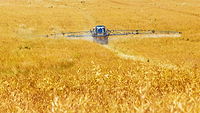EPA Proposal to Allow Use of Pesticide Chlormequat for Grains Raises Food Safety Concerns

Credit: Carl Newton via Unsplash
The U.S. Environmental Protection Agency (EPA) has proposed to register new uses for the pesticide chlormequat chloride on food crops. Before registering new uses, EPA must establish tolerances in or on barley, oat, triticale, and wheat.
If finalized, the decision would mark the first-ever approval for using chlormequat chloride on U.S. food.
Chlormequat chloride is currently registered for use as a plant growth regulator (PGR) in ornamentals grown in greenhouses and nurseries. EPA intends to allow the use of the pesticide on small grains like wheat, barley, oats, and triticale to address the issue of “lodging,” which is the bending over or breakage of stems. Lodging affects grain yield, harvestability, and quality.
As a PGR, chlormequat chloride application decreases the height of the grain plant stem, resulting in reduced lodging and potentially increased grain yield. According to EPA, compared to other PGRs with similar use patterns, the chemical allows for more flexibility in application timing, resulting in greater ease of use for small grain producers.
Before issuing this proposed registration decision, EPA assessed whether exposures to this product would cause unreasonable adverse effects to human health and the environment, as required by the Federal Insecticide, Rodenticide, and Fungicide Act (FIFRA). Based on EPA’s human health risk assessment, there are no dietary, residential, or aggregate (i.e., combined dietary and residential exposures) risks of concern. EPA’s ecological risk assessment identified no risks of concern to non-target, non-listed aquatic vertebrates that are listed under the Endangered Species Act, aquatic invertebrates, and aquatic and terrestrial plants.
The agency is proposing mitigation measures to address potential risks of concern to occupational workers as well as birds, reptiles, amphibians, mammals, and terrestrial invertebrates:
- Requiring personal protective equipment such as long-sleeve shirt, long pants, socks, shoes, and waterproof or chemical-resistant gloves to address occupational risks
- Requiring 24-hour restricted entry intervals, including posting signs at all reasonably expected points of worker entry to the treated area to address occupational risks of concern
- Requiring a mandatory and an advisory spray drift management statement to address ecological risks of concern.
The proposal is available for public comment in docket EPA-HQ-OPP-2021-0290 at www.regulations.gov and will close on May 26, 2023.
Food Safety Concerns
The Environmental Working Group (EWG) has raised concerns with EPA’s proposal. Grains are a staple in the U.S. diet, and there exists the possibility of dietary exposure to the chemical in the form of pesticide residues in foods. This is especially a concern for children, who are avid consumers of grain-based products.
EWG toxicologists assert that, based on animal studies, chlormequat can disrupt fetal growth and damage the reproductive system. Additionally, EWG states that the food safety risk posed by the use of the pesticide is unnecessary, as chlormequat is not required to successfully produce grain crops.
Although chlormequat is only allowed for use on ornamental plants in the U.S. at present, it is still found in the U.S. food supply due to chlormequat use on imported grains, which EWG demonstrated in a previous assessment of popular oat products eaten by children. EWG has submitted comments to the EPA strongly urging the agency not to allow chlormequat to be used on crops grown in the U.S.
Looking for a reprint of this article?
From high-res PDFs to custom plaques, order your copy today!





